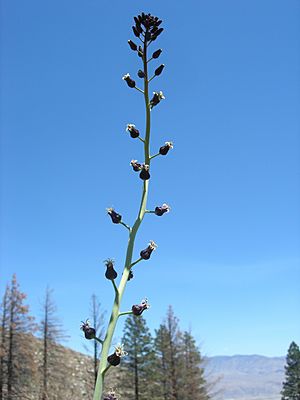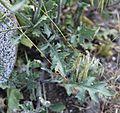Hairy wild cabbage facts for kids
Quick facts for kids Hairy wild cabbage |
|
|---|---|
 |
|
| Scientific classification | |
| Genus: |
Caulanthus
|
| Species: |
pilosus
|
The plant Caulanthus pilosus is a type of flowering plant often called hairy wild cabbage or chocolate drops. It belongs to the Brassicaceae family, which also includes plants like broccoli and mustard. This plant grows naturally in dry, open areas. You can find it in the Great Basin region of Nevada and the eastern side of the Sierra Nevada mountains. It also grows in nearby parts of the United States, reaching as far north as southeastern Oregon.
Caulanthus pilosus can be an annual plant, meaning it lives for only one growing season. Sometimes, it can be a perennial herb, living for more than two years. The plant is covered in thin hairs, especially near its base.
What Does Caulanthus pilosus Look Like?
Caulanthus pilosus can grow many stems from a single plant. Its leaves are shaped like long ovals and have deep cuts or "lobes" along their edges. These leaves are hairy and can grow up to 25 centimeters long.
As you look higher up the stem, the leaves become smaller. They might be thin and straight, without any lobes.
Flowers and Seedpods
The flowers of Caulanthus pilosus are quite interesting. They are covered by thick sepals, which are like small leaves that protect the flower bud. These sepals can be greenish-purple, deep purple, or even chocolate brown. When the sepals open, they show the wavy-edged, light-colored petals inside.
The flowers at the very top of each stem are usually sterile. This means they cannot produce seeds. After the flowers bloom, the plant forms long, narrow seedpods called siliques. These pods curve upwards and can grow up to 18 centimeters long. However, they are very thin, only about 1 to 1.5 millimeters wide.




